Birds of a Feather
Decoys from the Collection of the Shelburne Museum
By Rick Russack
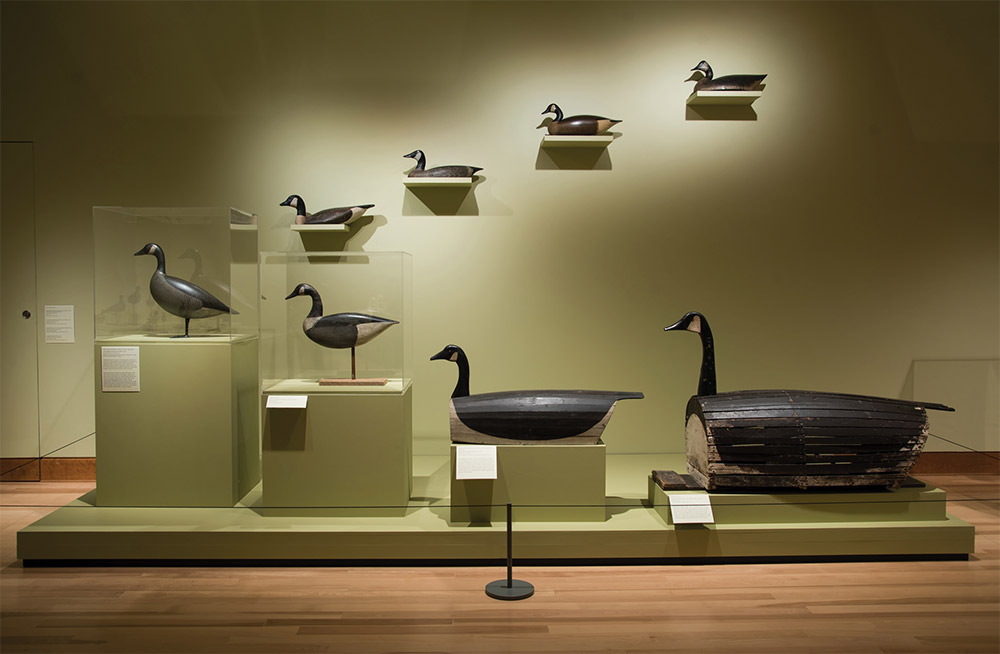
"Birds of a Feather: Shelburne Museum's Decoy Collection" remains on view in the Pizzagalli Center for Art and Education through May 1.
SHELBURNE, VT. — The Shelburne Museum has a collection of more than 1,400 decoys. About half of them have never been on public display. When renovations to Dorset House, their longtime home, are complete, they will all be on view. Meanwhile, 85 choice examples may be seen in the Pizzagalli Center for Art and Education in "Birds of a Feather." Up through May 1, the well-designed presentation includes equipment used by market gunners and, in an innovative and perhaps unprecedented approach, x-ray photos of the construction details of three decoys in the show.
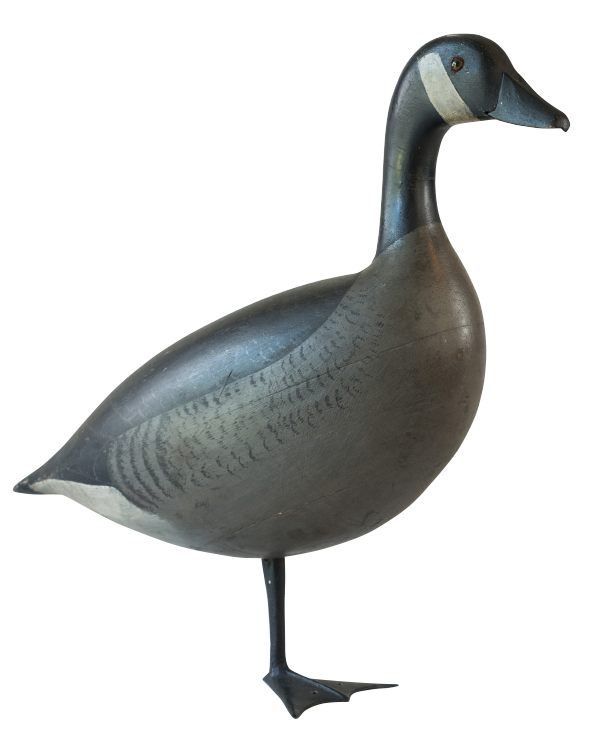
One–legged Canada goose decoy by Charles Schoenheider Sr, 1918. This goose with a single, cast iron leg is one of a dozen decoys made for a customer who refused to pay Schoenheider after receiving the Peoria, Ill., carver's $125 invoice. Schoenheider took the birds back and stored them, unused, in his attic. Wood, paint, glass, metal and iron; 19 3/8 by 8 by 26¼ inches. Acquired by trade from Charles Schoenheider Jr; Adele Earnest and Donal O'Brien.
Four hundred birds acquired by Shelburne Museum founder Electra Havemeyer Webb from Joel Barber in 1952 form the core of the collection. Barber started collecting decoys in 1918 and in 1934 published his seminal book Wild Fowl Decoys, which recognized carvings for their artistic and historic value. Webb bought Dorset House, an 1832 Greek Revival residence in East Dorset, Vt., and moved it to Shelburne to house her decoys. Her acquisition of the Barber objects inspired Richard H. Moeller and Edward H. Mulliken to bequeath their collections to the museum, which continues to add to its holdings.
Upon entering "Birds of a Feather," one immediately faces a wall of 13 outstanding duck decoys. In the center is a gem of the collection, a ruddy hen decoy by Lee Dudley. Lee and his twin brother, Lem, were market gunners. They lived on Knott's Island, N.C., and both carved. Their first birds date to about 1892. Many, including this one, are branded "LD." Experts believe the Dudleys made branded examples for their own use. Ruddy duck decoys are uncommon. The Dudley brothers are known for using distinct body shapes, unlike some carvers, who used the same body form with different heads for each species. Displayed near the ruddy hen is a brant decoy made by Nathan Cobb Jr, a market gunner from Cobb Island, Va. This decoy has glass eyes and a head and neck made from holly root, a trademark of Cobb's. Also on this wall is a whistler drake by Joseph Lincoln, a wigeon drake by Lem Ward and two sleepers by Albert Laing, one a broadbill drake and the other a surf scoter.
Most of the decoys are displayed in related groups, aiding in making comparisons between carvers and styles. Four mallards, including a drake and a hen by Shang Wheeler, are in one group. The influential Stratford, Conn., carver was a dedicated conservationist who, as a member of the state legislature, helped pass laws protecting wildlife. The mallard drake was awarded the grand prize at the Bellport Long Island Decoy Show in 1923.
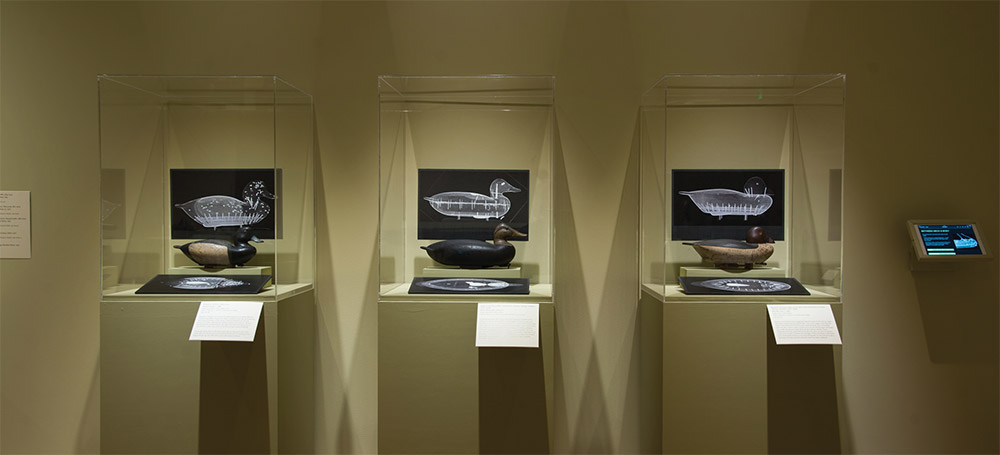
Three decoys are displayed with x-rays revealing their construction details.
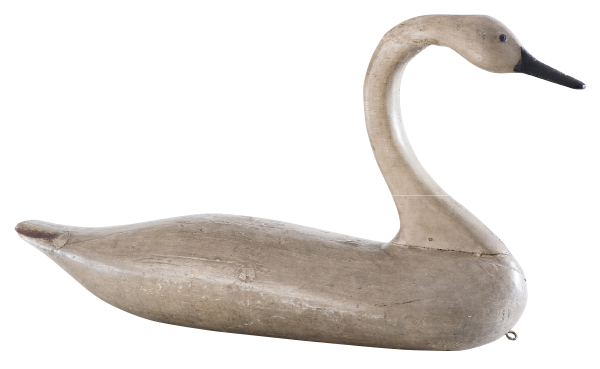
When Joel Barber discovered this circa 1890 swan decoy attributed to Sam Barnes, it was being used as a lawn ornament in front of a grape arbor. Since then, it has been exhibited worldwide and was even included in the 1958 Brussels Universal and International Exposition. Wood, paint and metal; 19 1/8 by 9½ by 36¼ inches. Gift of J. Watson Webb Jr, Harry H. and Samuel B. Webb, 1952. —Andy Duback photo
A group of six black ducks includes another Wheeler decoy and an exceptional preening black duck by Elmer Crowell. A very similar preening black duck by Crowell brought $210,000 at Steve O'Brien's decoy auction last July. The group of black ducks also includes examples by Albert Laing of Rahway, N.J., Gus Wilson of Portland, Maine, and a primitive example by Wilbur Corwin of Long Island, N.Y., which dates circa 1850.
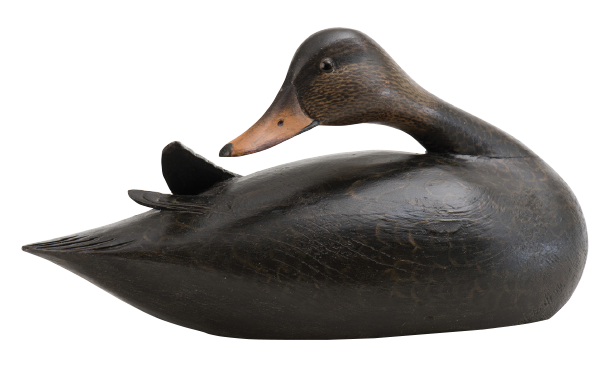
Black duck by A. Elmer Crowell, 1920. Crowell received his first shotgun when he was 12. By 14, he was using wooden decoys to hunt. This preening duck decoy is similar to one auctioned by Copley Fine Arts for $210,000 in July 2015. Wood and paint; 7½ by 16½ by 5¾ inches.
Included in a grouping of Canada goose decoys is a slat decoy that is more than 5 feet long by an unknown maker. Decoys of this size were often known as "quarter milers" because they could be seen by incoming flocks at a great distance. Popular on Cape Cod, slat decoys are often attributed to Joe Lincoln or Elmer Crowell. A smaller slat decoy attributed to Lincoln is in the same grouping.
Shown together, on a display simulating a pond, are several swan decoys, including two by contemporary carver Mark McNair. The group is led by a superb, circa 1890 swan made by Samuel Barnes of Havre de Grace, Md. Kory Rogers, Shelburne's curator of design arts, told Antiques and The Arts Weekly that that this swan decoy has "probably been seen by more people, either in photographs or in actuality, than any other American decoy." Since Joel Barber discovered it being used as a lawn ornament in front of a grape arbor, it has been featured in exhibitions around the United States and in Belgium at the Brussels Universal and International Exposition in 1958.
Although once a delicacy for European kings and queens, swans were considered inedible by most Americans because of their tough, sinewy meat. However, hunters along the Mid-Atlantic Seaboard from Maryland's Chesapeake Bay to the Currituck Sound off the North Carolina coast hunted young swans, known as cygnets, which were susceptible to the attraction of adult swan decoys.

X-ray of a swan by Samuel T. Barnes (1857–1926) provided information on the repairs in the joint between the head and the neck. You can count three screws holding that joint together and a void in the neck where an earlier metal fastener had been.
Two showcases display "confidence" decoys. They were carved to mimic bird species not hunted for sport or sustenance, such as egrets, herons, gulls and loons. They were commonly known as "confidence" birds because they were intended to create the illusion of a safe and biologically diverse environment, a suitable layover for migrating flocks. A striking grouping of three herons or cranes includes a spectacular life-size great blue heron carved by Elmer Crowell, circa 1912, and a wonderful folk art example by an unknown carver. Great blue herons are among the wariest of birds, and hunters often placed one of these decoys 50 or 100 yards away from the waterfowl decoys to create the impression of safety for ducks flying overhead.
Adjacent to this display is a case of three gull decoys, two by unknown carvers and one by Frank Kellam of Babylon, N.Y. Gulls have also been used for many years to create the "natural" look needed to bring geese and ducks into range.
Shelburne has a large collection of shorebird decoys, or "stick-ups" as they are known, designed to be shoved into sandy beaches. From the 1860s until the end of World War I, plovers, curlews, yellow legs, dowitchers and other shorebirds were the victims of unregulated market gunning.
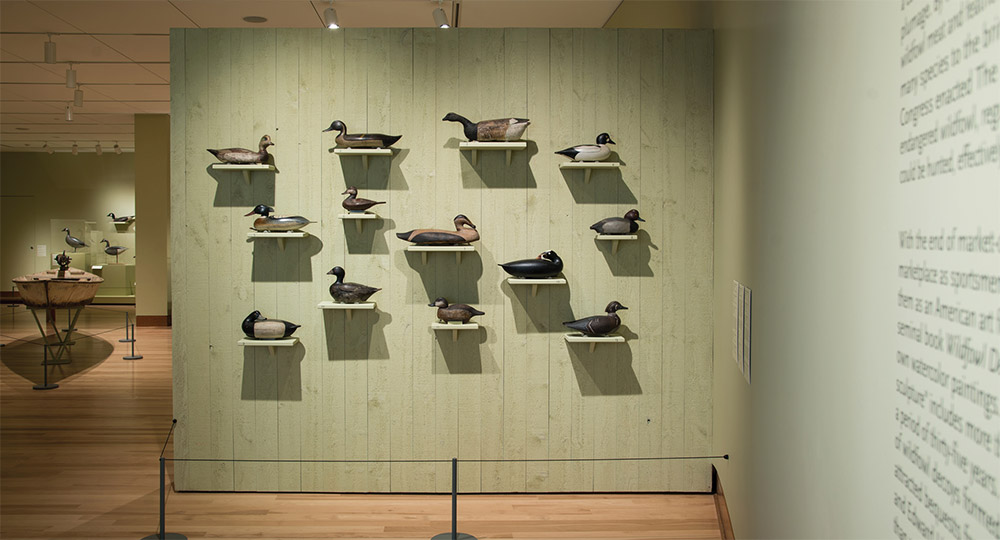
This wall of 13 ducks sets the tone for the exhibit. Adjacent signage explains the context for the decoys.

Mallard drake and hen decoys by Charles "Shang" Wheeler, 1922–23. Wood, glass, paint, metal and leather; 5 1/8 by 6 by 17 5/8 inches. Gift of J. Watson Webb Jr, Harry H. and Samuel B. Webb. —J. David Bohl photo

Ruddy duck hen decoy by Lee Dudley, before 1900. Many collectors consider this decoy, commonly called the "Crown Jewel of North Carolina," the best in Shelburne's collection. Wood, paint, metal and leather; 6 by 4¾ by 9½ inches. Gift of J. Watson Webb Jr, Harry H. and Samuel B. Webb, 1952. —Andy Duback photo
Aided by inventions such as punt guns and the quick loading breech shotgun in the 1870s, market gunners who supplied fresh game to urban butchers' shops and restaurants were responsible for hunting many of North America's shorebirds to the brink of extinction. In 1918, Congress passed the Migratory Bird Treaty Act, designed to regulate and protect migratory birds. The original agreement was between the United States and Great Britain, acting for Canada; other countries signed on later. Several shore birds from the museum's collection are displayed in groups on a platform resembling a seashore. Some rare construction types are included, such as a group of stick-up silhouettes by an unknown carver and decoys utilizing dovetailed heads, also by an unknown maker. The display includes shorebird masterpieces, such as a preening greater yellowlegs by Elmer Crowell and works by other masters, including Thomas Gelston and William Bowman. An outstanding Mason Factory curlew is part of this grouping and is the only manufactured bird in the exhibit.
We often hear the term "market gunner," but two large items in this exhibit demonstrate exactly what the term means. A skiff in the gallery includes a large caliber shotgun, called a "punt gun," capable of killing up to 100 birds with a single shot. Some punt guns could fire a full pound of shot. The one on display is about 8 feet long, weighs close to 200 pounds and is mounted on a swivel mechanism that assisted aiming the huge gun. Some market gunners used shotguns with triple barrels. Punt guns were outlawed by the Migratory Bird Treaty Act of 1918.
Also on display is a large sinkbox, described by Ferdinand C. Latrobe, a dedicated hunter and seven-term mayor of Baltimore in the late 1800s, as "a wholesale murdering sort of thing that has little 'sport' about it." Sinkboxes were one of the deadliest and most controversial types of watercraft used to hunt wildfowl. Essentially floating blinds, sinkboxes allowed hunters to lie (or, in the case of the one on display, crouch) beneath the waterline, making themselves almost completely invisible to birds overhead.
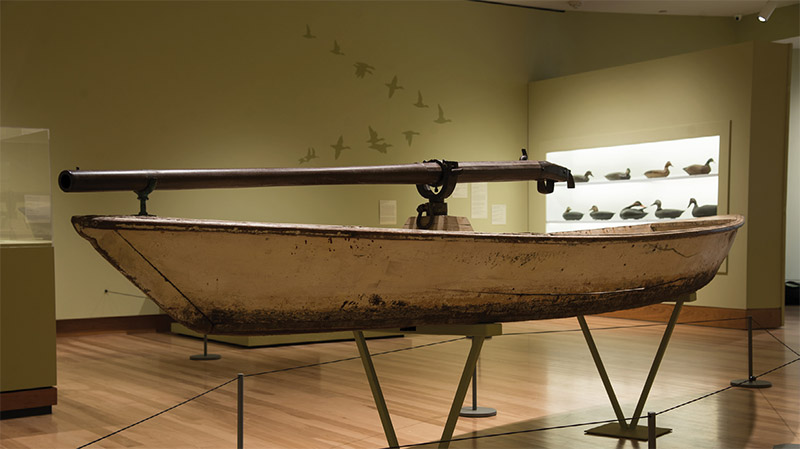
Captain John Elliott, a market gunner from Maryland, owned this gunning skiff. The shotgun is about 8 feet long, weighs about 200 pounds and is capable of killing up to 100 birds with a single shot. Using a gun like this for this purpose has been illegal since 1918.
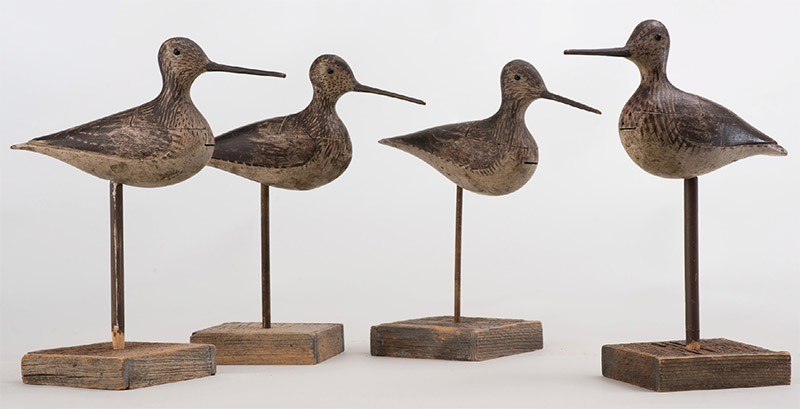
Stick-up shorebird dowitcher decoys, maker unknown, before 1900. Wood, paint and glass; 9¼ by 3 15/16 by 8¾ inches. Museum purchase, acquired from Richard Moeller, 1956.
—Andy Duback photo
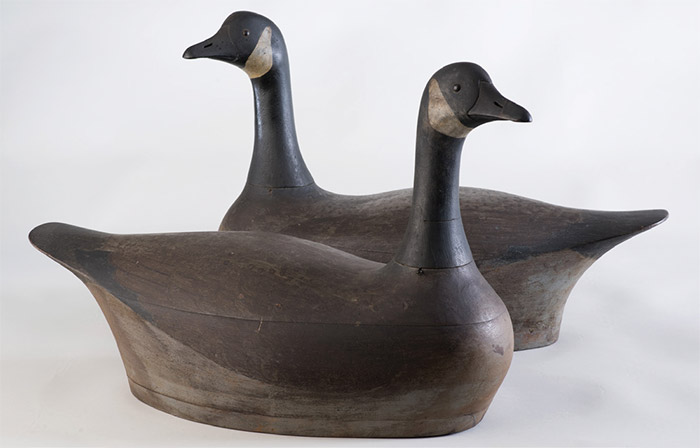
Canada goose decoys by Captain Charles Osgood, circa 1849. Wood, paint, metal and leather; 16¾ by 11½ by 24 inches. Gift of Mrs P.H.B. Frelinghuysen, 1953. —Andy Duback photo
The boxes were held in place by a system of anchor weights and heavy cast iron decoys provided ballast to keep the box flush with the waterline. Large, removable canvas-covered wings were added to each side of the platform to prevent waves from spilling into the box, sinking the blind and drowning the hunter. Three cast-iron decoys, each weighing 24 pounds, are on display. This sinkbox was found in the Bay of Fundy and has a folky frieze of eider drakes and hens painted on both the exterior and interior of the upright frame around the box. Franklin Roosevelt outlawed use of sinkboxes in 1935.
A gunning skiff, designed and built by Shang Wheeler, is also on view.
With assistance from the University of Vermont Medical Center in nearby Burlington, Shelburne, in what may be an unprecedented approach to presenting decoys, paired the sculptures with radiographic scans of their interiors. The photographs reveal how different makers used screws and nails, document internal markings left by tools and help answer attribution questions. For instance, the radiograph of a bluebill drake by Benjamin Holmes illustrates his distinctive habit of hollowing out the top portion of the duck, a technique at odds with that of Albert Laing. An iPad adjacent to these display cases has an interactive, multimedia slide show with x-ray images and CT scans of three other decoys displayed elsewhere in the show.
Nancie Ravenel, Shelburne's object conservator, explained to Antiques and The Arts Weekly that the use of radiography to examine cultural history objects has a long history. The first paper on the subject was published in 1898, just three years after Wilhelm Roentgen published his first x-ray images of his wife's hand.

Bluebill drake by Benjamin Holmes (1843–1912), circa 1880. Holmes constructed his decoy bodies in a slightly different manner than Albert Laing (1811–1886). Instead of carving and hollowing out a top and bottom, Holmes hollowed out the top portion, then adhered and nailed a board to the bottom. On these x-ray photos, shot from the side and from above, the bright white dots in the head and body are likely to be bird shot. Gift of J. Watson Webb Jr, Harry H. and Samuel B. Webb.
Many thanks to Kory Rogers for his assistance with this article.
The Shelburne Museum is at 6000 Shelburne Road, Shelburne, VT. Information: www.shelburnemuseum.org or 802-985-3346.
Rick Russack is a regular contributor to Antiques and The Arts Weekly. A history buff and retired book dealer, he lives in a 1760s house in New Hampshire with his rescue dog, Charlie.
View Article in PDF »
Credits
Used with Permission. Rick Russack and Antiques and the Arts Weekly, The Bee Publishing Company, Newtown, Connecticut. February 12, 2016.